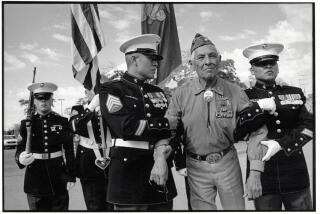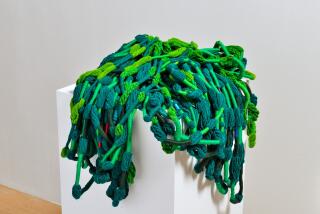Making a Blanket Statement
The Navajo Indians had no chiefs. This would come as a great shock and sacrilege to many of the sachems in Washington and in several executive suites.
Nancy Blomberg told me that. She is the assistant curator of anthropology at the Los Angeles County Museum of Natural History who assembled that rich collection of textiles called “Art From the Navajo Loom,” on display at the venerable museum we used to call Exposition Park.
I have loved that museum since I was a small girl. It has always had great stuff, of which my favorites were the mummies and the dinosaur bones. I must have been an odd little thing with a great sense of the macabre.
In the last few years, the museum director and distinguished board have hauled the old bone house into a spectacular new career. Now the exhibits are exciting and dawn-fresh. I love it more than ever.
The exhibit of Navajo weaving is a bright and shining example. There are 60 pieces on display, part of the cache of more than 200 presented to the museum in 1942 by William Randolph Hearst, an omnivorous buyer of almost everything.
At first Hearst intended that the collection be displayed on the walls of San Simeon, the castle of marble and stone and jewels that the first media mogul built on a spread of green hills overlooking the ocean. But the castle took a turn toward the classic, and with statues of cavorting nymphs everywhere, someone had the courage to say, “No, W. R., not the Indian stuff with the Greek stuff,” and that was the Natural History Museum’s good fortune.
The Navajos began their weaving in the mid-17th Century and learned it from the Pueblo Indians who had been weaving beauty since 1100. The Pueblos’ weaving was all for ceremonial purposes, but the Navajos decided to make things they could use--blankets, saddle blankets and finally rugs.
Hearst saw a display of Navajo weaving in 1900 when he was passing through Chicago on the Santa Fe Railroad. He loved it and appreciated the fine workmanship of the Indians.
Nancy Blomberg has found a sheaf of correspondence between Hearst and Herman Schweizer, manager of the Fred Harvey Co.’s Indian Department. The Fred Harvey Co. was owned by the Santa Fe Railroad, and built shops displaying Indian crafts at the larger railway stations. When the passengers clambered off the Sante Fe trains to buy post cards and stretch their legs, they ran the gamut of Indian artisans, potters, weavers, basket makers, jewelers, all offering their exotic wares for sale. The picturesque Indians were paid by the Santa Fe Railroad to sit there and look colorful so that passengers would continue their train trip west.
The first Indian weaving was done with cotton but when the Spanish came to the newly opened continent, they brought sheep and the Indians changed to wool.
The Navajos used the natural colors in the sheep’s wool, white, gray, brown and black, and then they began to use plants and insects for dyes. They wanted still brighter colors and when the Spanish traders came through, they offered bright scarlet wool fabric for sale. The Navajos bought it and unraveled it, one strand at a time, to add to their black, gray, brown and white blankets.
They called the tightly woven blankets chiefs’ blankets and sold them to the Pueblo Indians, who had chiefs, and to travelers with power and cash.
They began to weave rugs when the Fred Harvey Co. convinced them that the crazy people on the trains would buy them. Buy they did, and the Indians even copied patterns from Oriental rugs, wonderfully designed and richly colored. They were heavier than the blankets and became a symbol of travel and sophistication in Victorian homes.
Aniline dyes were developed in England in 1856 and it took just 10 years for them to find their way to the Navajo weavers. Then the red and black blankets and rugs began to have patches of orange and turquoise.
The Navajos say that weaving was taught to them by the Spider Woman and that “When a girl child is born to your tribe, you shall go and find a spider web. You must then rub it on the baby’s arms and hands. Thus, when she is grown, she will weave and her fingers and arms will never tire.”
Eventually, William Randolph Hearst had bought the prime pieces from the carefully researched collection of Herman Schweizer. It is a magnificent collection, each piece woven on the Navajo loom, which has not changed its design since the 1600s. It shows Hearst’s knowledge, taste and discrimination.
The exhibit will be on display until July 31, 10 a.m. to 5 p.m. Tuesdays through Sundays. Admission is $3 for adults, $1.50 for senior citizens and students older than 12 with ID. Children younger than 5 are free but they’ll prefer the mummies, anyway.
More to Read
Sign up for Essential California
The most important California stories and recommendations in your inbox every morning.
You may occasionally receive promotional content from the Los Angeles Times.










